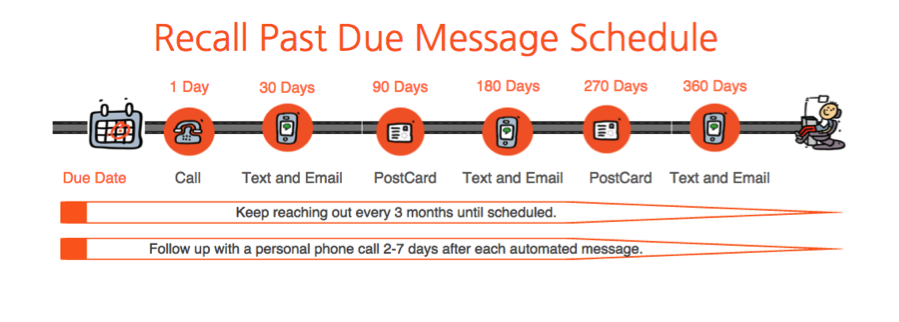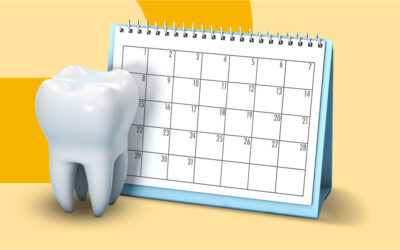
Maintaining patient recall is necessary to run an efficient practice. When you bring in new patients, you want to keep them! A consistent and considerately planned recall strategy aids patient retention.
What about those patients who are unreachable and have not come in for an extended period of time? It might seem sensible to dismiss inactive patients to focus on those with recall due. But it’s important to include both recall due and recall past-due patients in your strategy.
To distinguish, recall due means that the patient is soon due for a cleaning or treatment. Recall past due means that they have skipped their scheduled visit. Patients can be past due for a day, a month or years. They are considered past due until they return for an appointment.
Related: Create the Perfect Reactivation Email
During this time, it’s possible the patient has gone for treatment elsewhere. However, never remove them unless they have made it clear they will not return. You never know when they might seek your care in the future.
In order to gain back inactive patients, you must first figure out who your inactive patients are. Consult your recall past due list in YAPI. Our best practices for recall schedule shows the suggested method to target overdue patients at different stages. We recommend contacting overdue patients every three months until they’ve got an appointment on the calendar.
Here are six methods to include in your reactivation strategy for noticeable results:
1. Phone Call Reminders
- Best for all inactive patients.
Designate an amount of time each week that works for you to personally reach out to inactive patients. We love automated text and email messages because they have a high open rate and make it easy for patients to respond. Though, the effectiveness of the traditional phone call should not be overlooked! Voicemail messages are easily ignored but a personal phone call works wonders to get an appointment on the schedule.
Phone calls are one of the best ways to reach out because:
- It’s harder to say no to someone on the phone than in an email.
- The scheduling coordinator will be able to individually address concerns.
- The patient feels more committed to keeping the appointment if they tell you they’ll be there.
You don’t have to devote too much time to making calls, but you should be consistent in meeting your scheduled allotment. If you have a slow day and can afford to spend more time making calls, do it. Keep a system and record who you called and when. With YAPI, you can add a note after each call attempt to the patient’s file. You might choose to start with patients that are up to a month overdue and move on from there.
Remember: Follow-up with a personal call 2 to 7 days after each automated email or text message.
2. Text Message Reminders
- Best for all inactive patients.
A text is quick and noticeable. Text messages also have an open rate of 98% according to Mobile Marketing Watch. That is higher than any other method. A program such as YAPI allows patients to reply to the text with an appointment time request. This convenience will encourage many overdue patients to schedule an appointment.
Here’s a sample text you might send:
We realized we haven’t seen you in a while! Call 408-598-8998 or reply to this text to schedule your next dental appointment.
3. Practice Newsletter
- Best for all inactive patients.
A monthly or seasonal practice newsletter is a great marketing tool to build relationships with your existing and inactive patients.
Some ideas to include:
- New procedures and offerings
- Financing options
- Hours of operation updates
- Staff interviews
- Fun facts about your team members
- A “patient of the month” feature (with their consent)
Be creative and show your team’s personality to really connect with your patients. A newsletter is an opportunity to market your practice in an enjoyable way.
4. Postcard Reminders
An email or text message can be easily overlooked among the rest. Postcards work well because of their visibility in a patient’s mailbox. Unfortunately, postcard marketing can quickly get expensive. YAPI makes it affordable by allowing each practice to print postcards directly from their Practice Dashboard for pennies on the dollar.
Most patients will notice a postcard in the mailbox. The only downside is when the patient receives your postcard and intends to call but forgets. That is why you should always follow-up with a personal phone call about a week after mailing a postcard. Your postcard will put you at the top of their mind. When you call them, you are likely to hear: “I am so glad you called, I’ve been meaning to call you!”
Be very specific and include:
- The names of each person in the household
- Their last appointment date
- What they are due for
5. End-of-Year Benefits Postcard or Email
- Best for all inactive patients before the year’s end.
The end of the year is an optimal time to encourage patients to take advantage of their benefits before they expire. You can send this reminder in postcard or email form. If the patient wants direct mailings, postcards are visual and work great. If not, send a targeted email campaign, alerting them that the year is coming to a close and now is the moment to take advantage of their benefits.
Many patients will appreciate this gesture. It could be just the reminder they need to take action and schedule their appointment before it’s too late.
6. Email Blasts
- Best for patients that are over a year past due.
The longer a patient has not been in your office, the more challenging it will be to get them back in. That’s why email blasts are perfect; it’s not worth it to spend too much marketing revenue on those patients.
Create an email campaign to send to long overdue patients. The email text should be short but personable. Try to address the “root” of the problem. Since emails have a high open rate and are economical, they are your best first-line reach out attempt to get a patient on the schedule. We recommend sending a different template, each focusing on a particular reason or topic, every three months.
Don’t give up on your inactive patients! Instead, use our strategies above to reel them back in. Failing to stay in touch with your patients is like asking them not to return. Think of communication with your overdue patients as an opportunity, not a hassle. These six techniques will help get you (and them) back on track.



